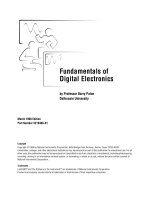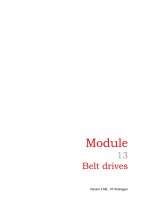- Trang chủ >>
- Khoa Học Tự Nhiên >>
- Vật lý
Fundamentals of Touch Technologies
Bạn đang xem bản rút gọn của tài liệu. Xem và tải ngay bản đầy đủ của tài liệu tại đây (9.4 MB, 247 trang )
Fundamentals of
Touch Technologies
Geoff Walker
Senior Touch Technologist
Intel Corporation
v1.1
Updated October, 2013
1
v1.3
File Download: www.walkermobile.com/Touch_Technologies_Tutorial_Latest_Version.pdf
Agenda…1
Course structure
Topic Allocation
Introduction 6%
Main Content 88%
Capacitive – 1 32%
Resistive – 2 9%
Acoustic – 3 8%
Optical – 4 20%
Embedded – 5 13%
Other – 6 2%
Active Stylus – 7 6%
Software – 8 10%
Conclusions 6%
TOTAL 100% 100%
6 fundamental touch technologies with ~20 types
2
Agenda…2
Admin
Introduction to Touch Technologies
Capacitive (1)
1A - Projected Capacitive (P-Cap)
ITO Replacement Materials
1B - Surface Capacitive
Resistive (2)
2A - Analog Resistive
2B - Analog Multi-Touch Resistive (AMR)
2C - Digital Multi-Touch Resistive
Acoustic (3)
3A - Surface Acoustic Wave (SAW)
3B - Acoustic Pulse Recognition (APR by Elo Touch Solutions)
3C - Dispersive Signal Technology (DST by 3M Touch Systems)
3
Agenda…3
Optical (4)
4A - Traditional Infrared
4B - Waveguide Infrared (DVT by RPO)
4C - Multi-Touch Infrared
4D - Camera-Based Optical
4E - Planar Scatter Detection (PSD by FlatFrog)
4F - Vision-Based
Embedded (5)
LCD Architecture Refresher & Terminology Review
Hybrid In-Cell Mutual Capacitive for IPS & Non-IPS LCDs
On-Cell P-Cap
In-Cell Light-Sensing
In-Cell “Pressed” Capacitive
In-Cell Voltage-Sensing
In-Cell Self-Capacitive
Embedded Touch Issues
4
Agenda…4
Other Touch Technologies (6)
Force-Sensing
Active-Stylus Technologies (7)
Electromagnetic Resonance (EMR) Stylus
P-Cap Stylus
Other Active Stylus Technologies
Software (8)
Multi-Touch
Operating-System Application-Development Support
Middleware
5
Agenda…5
Conclusions
Touch Technology vs. Application
Usability, Performance, and Integration Characteristics
Touch Technology Primary Advantages and Flaws
Predictions for the Future
Suggested Reading on Touch
Recommended Conferences and Trade Shows on Touch
6
Introduction
Source: Gizmodo
7
(Michelangelo's "The Creation Of Adam“, in the Sistine Chapel, 1511)
File Download: www.walkermobile.com/Touch_Technologies_Tutorial_Latest_Version.pdf
Two Basic Categories of Touch
Opaque (non-transparent) touch
Dominated by the controller chip suppliers
● Atmel, Cypress, Synaptics, etc.
● One technology (projected [self] capacitive)
● Sensor is typically developed by the device OEM
Notebook touchpads are the highest-revenue application
● Synaptics, Alps and ELAN have the majority of the market
● Sensors are all two-layer projected capacitive
There is no further discussion of opaque touch in this course
Transparent touch on top of a display
Dominated by the touch module manufacturers
(150+ worldwide)
6 fundamental technologies with ~20 types
8
Overall Touchscreen Market
2012-2017
Source: DisplaySearch Quarterly Touch-Panel Market Analysis Report (June 2013)
1.3
1.6
1.8
2.1
2.3
2.4
0.0
0.5
1.0
1.5
2.0
2.5
3.0
2012 2013 2014 2015 2016 2017
$24.2
$34.2
$39.1
$43.4
$46.0
$46.2
$0.0
$5.0
$10.0
$15.0
$20.0
$25.0
$30.0
$35.0
$40.0
$45.0
$50.0
$55.0
2012 2013 2014 2015 2016 2017
Units (Billions) Revenue ($Billions)
2012-2017
CAGR = 13.0%
2012-2017
CAGR = 13.8%
Touch in 2007 was 308M units & $1.3B…
9
Touchscreen Market 2007-2017
by Technology (Units)
% of Units Shipped
Source: DisplaySearch Touch-Panel Market Analysis Reports 2008-2013
10
4%
13%
23%
41%
62%
63%
58%
59%
60%
61%
63%
93%
85%
75%
57%
28%
20%
16%
13%
11%
9%
8%
8%
9%
12%
15%
15%
14%
14%
6%
11%
10%
11%
12%
13%
3%
2%
1%
3%
2%
2%
3% 3%
3%
3%
3%
0%
10%
20%
30%
40%
50%
60%
70%
80%
90%
100%
2007A 2008A 2009A 2010A 2011A 2012A 2013F 2014F 2015F 2016F 2017F
Other Technologies
In-Cell (P-Cap)
On-Cell (P-Cap)
Resistive
P-Cap
Touch Technologies
by Size & Application
#
Touch Technology
Mobile
(2” – 17”)
Stationary
Commercial
(10” – 30”)
Stationary
Consumer
(10” – 30”)
Large-Format
( >30”)
1A Projected Capacitive M M L L
1B Surface Capacitive M
2A Analog Resistive M M L
2B Analog Multi-Touch Resistive (AMR) E E
2C Digital Multi-Touch Resistive (DMR) E
3A Surface Acoustic Wave (SAW) M L
3B Acoustic Pulse Recognition (APR) E L
3C Dispersive Signal Technology (DST) L
4A Traditional Infrared (IR) M M
4B Multi-Touch Infrared E E E E
4C Camera-Based Optical M M
4D Planar Scatter Detection (PSD) E
4E Vision-Based (In-Cell Optical) E
5 Embedded (In-Cell/On-Cell Capacitive) M E
6 Force Sensing E
11
M = Mainstream L = Low-volume E = Emerging
Touch Technology
Transparent
Conductor (ITO)
No Transparent
Conductor
Patterned
Surface capacitive
Low
Resolution
Analog & digital
multi-touch
resistive (AMR
& DMR)
Projected
capacitive
Embedded
(In-cell &
on-cell)
Dispersive Signal
Technology (DST)
Camera-based
Force sensing
Vision-based
Surface acoustic wave (SAW)
Acoustic Pulse
Recognition (APR)
Analog resistive
Traditional infrared (IR)
Planar scatter detection (PSD)
Touch Technologies
by Materials & Process
= Emerging or Low-Volume
= Mainstream
Multi-touch infrared
Continuous
Edge Conductors
High
Resolution
No Edge
Conductors
12
A Simple Touch Isn’t Simple…1
13
Touch classification from the University of Toronto
Source: Daniel Wigdor
Example:
iPhone/iPad
A Simple Touch Isn’t Simple…2
14
It’s far more complex than just “how many touches?”
The Breadth vs.
Depth Problem
Re-design software
for each platform’s
capabilities
(narrow breadth,
deep functionality)
Design software
once for common
capabilities
(wide breadth,
limited functionality)
?
Touch Is An Indirect Measurement
15
Touch Technology What’s Being Measured
Projected capacitive,
Embedded (capacitive)
Change in capacitance
Surface capacitive Current
Resistive (all forms) &
Embedded (voltage-sensing)
Voltage
Surface acoustic wave Ultrasonic wave amplitude
Acoustic Pulse Recognition &
Dispersive Signal Technology
Bending waves
Infrared & camera-based (all forms),
Planar Scatter Detection
Absence or reduction
of light
Vision-based Change in image
Embedded (light-sensing) Presence of light
Force sensing Force
The ideal method of sensing
touch has yet to be invented!
This is one reason why there are so many technologies
16
Projected Capacitive (P-Cap)
ITO-Replacement Materials
Surface Capacitive
Capacitive Touch Technologies
File Download: www.walkermobile.com/Touch_Technologies_Tutorial_Latest_Version.pdf
Projected
Capacitive
Source: Apple
17
File Download: www.walkermobile.com/Touch_Technologies_Tutorial_Latest_Version.pdf
Projected Capacitive…1
iPhone, iPad and other products using projected
capacitive (p-cap) have set the standard for touch
in SEVERAL BILLION consumers’ minds
Multiple simultaneous touches
Extremely light touch
Flush surface (zero-bezel)
Excellent optical performance
Reliable and durable
Fully integrated into the user
experience – effortless & fun
Source: TabletPC2.com
18
Projected Capacitive…2
Self-capacitance principle
Source: 3M
19
Projected Capacitive…3
Self-capacitance electrode variations
Source:
3M
Multiple separate pads
in a single layer
Each pad is scanned
individually
Rows and columns of electrodes
in two layers
Row & column electrodes are
scanned in sequence
20
Self Capacitance
Mutual Capacitance
Projected Capacitive…4
The problem with self-capacitance
Source: Touch International
Touches that are diagonally separated produce
two maximums on each axis (real points & ghost points)
● Ghost points: False touches positionally related to real touches
No
Ghost
Points!
21
Projected Capacitive…5
Mutual-capacitance principle
Source: 3M
Touch
No touch
“Projected”
electric field
22
Projected Capacitive…6
Mutual capacitance example (Apple iPhone)
Output is an
array of
capacitance
values for each
X-Y
intersection
Source: Apple
Source: The Author
23
Projected Capacitive…7
Raw data including noise
Touch regions
Touch region coordinates
and gradient data
Filtered data
Gradient data
Source: Apple Patent Application #2006/0097991
“10 fingers,
2 palms
and
3 others”
24
Projected Capacitive…8
“Interlocking diamond” electrode configuration
25
Source: Atmel
RED
(Drive)
BLUE (Sense)
4.5 mm typical
Source: 3M









